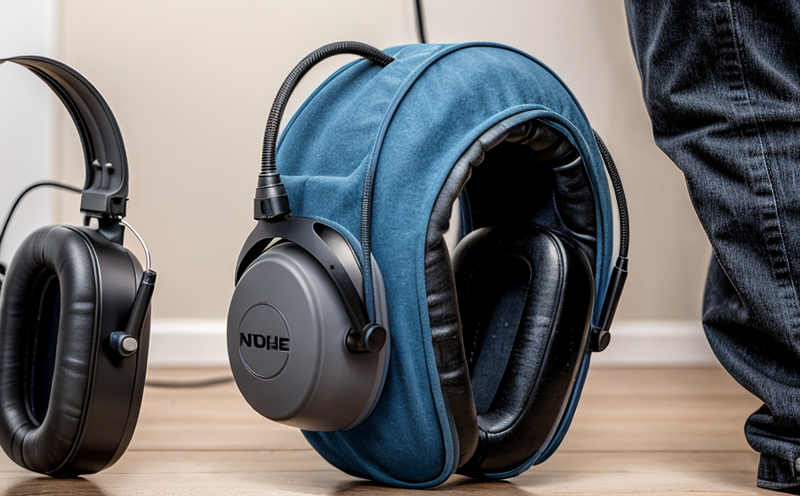EN ISO 4869-7 Hearing Protector Communications Testing
The EN ISO 4869 series of standards provides a comprehensive framework for testing hearing protectors, ensuring they meet the necessary performance criteria in various scenarios. Specifically, Part 7 of this standard focuses on the evaluation of hearing protector communications capabilities under noise conditions that are typical in industrial workplaces. This service ensures that hearing protection devices (HPDs) not only reduce ambient noise effectively but also allow clear communication between workers.
The testing procedure outlined in EN ISO 4869-7 is designed to simulate real-world working environments where noise can interfere with speech intelligibility and thus, worker safety. The test involves placing the HPD on a subject who then engages in conversations while exposed to background noise levels that mimic typical industrial settings. The primary objective is to determine if the HPD allows for adequate understanding of speech despite the presence of noise.
This service is crucial for ensuring occupational health and safety, especially in sectors where prolonged exposure to high decibels could lead to hearing damage or impaired communication among workers. Compliance with this standard helps employers meet their obligations under workplace health and safety regulations while also enhancing productivity by maintaining effective communication channels within teams.
Compliance with EN ISO 4869-7 is mandatory for manufacturers of HPDs looking to gain market access in Europe or other regions that recognize these standards. It guarantees that the products meet stringent international requirements, thereby protecting both workers and employers from potential liabilities associated with substandard equipment.
The testing process itself involves precise calibration of sound sources and measurement instruments to ensure accurate results. Subjects wear the HPD while listening to pre-recorded speech samples presented in noisy environments. The level of speech intelligibility is then compared against a reference without any hearing protection to assess performance accurately. This meticulous approach ensures that only devices capable of maintaining safe noise exposure limits while still allowing clear communication pass this stringent test.
For industries such as manufacturing, construction, mining, and oil & gas, where heavy machinery generates substantial noise levels, ensuring proper communication among workers is paramount for both efficiency and safety. By adhering to EN ISO 4869-7, organizations demonstrate their commitment to fostering a safer work environment while simultaneously complying with regulatory requirements.
In summary, the EN ISO 4869-7 Hearing Protector Communications Testing service plays an essential role in safeguarding worker health and enhancing productivity. It provides peace of mind knowing that the hearing protection devices used are reliable and meet international standards, thereby reducing risks associated with noise-induced hearing loss.
Why It Matters
The importance of EN ISO 4869-7 cannot be overstated in the context of occupational safety. In industrial settings, workers often face challenging acoustic environments due to machinery noise and other sources. Ensuring that hearing protection devices allow for clear communication is critical because it directly impacts worker safety and productivity.
Effective communication among employees working under noisy conditions can prevent accidents caused by miscommunication or misunderstanding of instructions. For instance, in emergency situations where quick response is crucial, having reliable HPDs that facilitate clear voice transmission could save lives. Moreover, maintaining good inter-team communication helps improve workflow efficiency and overall job satisfaction.
From a legal perspective, compliance with EN ISO 4869-7 demonstrates an organization's adherence to relevant health and safety regulations. This can help reduce liability risks should incidents arise due to improperly functioning hearing protection equipment. Employers who invest in this testing service not only protect their employees but also uphold their reputation as responsible corporate citizens.
Additionally, the results of EN ISO 4869-7 tests provide valuable data that can inform product development and improvement efforts within manufacturing facilities. Manufacturers can use these insights to enhance the design and functionality of future hearing protection models, further improving worker safety and comfort.
In conclusion, implementing the EN ISO 4869-7 Hearing Protector Communications Testing service is not just about meeting regulatory standards; it's a proactive measure that contributes significantly towards creating safer workplaces and promoting better working conditions overall.
Applied Standards
| Standard | Description |
|---|---|
| EN ISO 4869-7 | This part of the standard specifies requirements and test methods for determining whether hearing protectors permit effective communication in noisy environments. It addresses speech intelligibility under conditions that simulate typical industrial noise levels. |
Scope and Methodology
The scope of the EN ISO 4869-7 Hearing Protector Communications Testing is broad, encompassing all types of hearing protectors intended for use in industrial settings. The methodology involves several key steps:
The testing begins with the preparation and calibration of the test equipment to ensure accuracy. Subjects participating in the tests wear the HPD being evaluated while facing a speaker delivering recorded speech samples against background noise generated by industrial machinery. The noise levels are adjusted according to specified criteria laid down in EN ISO 4869-7.
The speech samples are carefully chosen to represent common phrases used in workplace communication. The subjects' ability to understand these statements with and without the HPD is recorded. A control group without any hearing protection serves as a baseline for comparison.
Speech intelligibility scores are calculated based on how accurately the listeners can repeat back what they heard from the speaker. These scores are then compared against predefined thresholds specified in EN ISO 4869-7 to determine if the HPD meets the required standards.
The test also includes checks for other factors that could affect communication, such as echo cancellation and feedback reduction features in certain models of HPDs. By incorporating these additional metrics, the testing process ensures a holistic assessment of each device's performance under realistic conditions.
In summary, the EN ISO 4869-7 Hearing Protector Communications Testing service employs rigorous procedures to evaluate hearing protector communication capabilities accurately and consistently across different brands and models.





